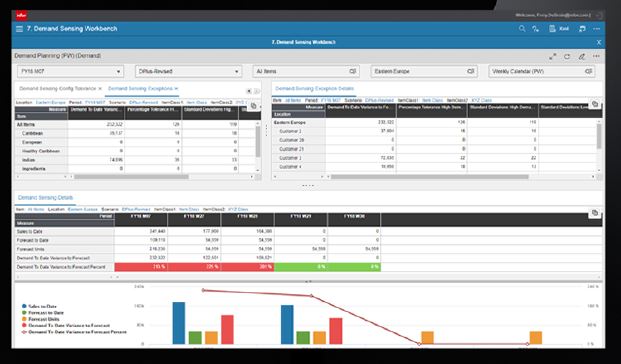When sales forecasting software accurately anticipates demand planning, then it is a key element in the efficient management of your business.
With ever-increasing information sources and data volumes, it’s essential to use high-performance tools to manage and forecast demand accurately.
That’s where Infor Demand Planning comes in.
Withyears of experience and ongoing development, it offers a robust solution for anticipating your company’s future needs, without the need for a crystal ball.

Sales forecasting software — Infor Demand Planning
Developed by Mercia Software and merged with Agilisys when acquired by Infor, previous versions of Infor Demand Planning are known as MLE — Mercia Lincs Entreprise and Infor MLE Demand Planning.
Demand Planning is an essential module in the Infor Supply Chain Planning suite, designed to simplify the management of sales forecasts for companies.
This module offers advanced features to meet the challenges of demand planning. With Infor Demand Planning, you can easily process large volumes of data, with up to 5 million different products and channels.
Thanks to the use of probabilistic forecasting methods and machine learning, this software guarantees optimum accuracy in your forecasts.
This module provides organizations, forecasters and sales teams with a fast, highly collaborative demand planning platform to solve forecasting challenges once and for all:
- Automated deviation detection
- Alert-based operation, to focus the forecaster’s attention on what counts: his added value
- Optimization of consistent and seasonal demand models
- Real-time monitoring of changes to adjust forecasts
Sales forecasting software features — Infor Demand Planning
Managing special cases
Infor Demand Planning enables efficient management of sporadic requests and special cases such as promotions, special events and special offers.
You can monitor their impact on future forecasts, and obtain relevant forecasts by quickly detecting variations in the behavior of items with erratic demand.
Even with limited or non-existent historical data, such as a new product, the software uses similarities in behavior, either historical or predicted, and delivers quality forecasts. This also works for slow-moving items.
What-if simulation scenarios
With the what-if scenarios feature, your forecasters can simulate different situations and compare results to make informed decisions.
Whether for estimating different scenarios, sharing scenarios with stakeholders (management, marketing, production…) or facilitating the sales and operations planning (S&OP) process, Demand Planning offers a precise and rapid approach to evaluating options.
Machine learning for reliable forecasting
Demand Planning uses machine learning techniques to continuously improve the accuracy of your forecasts.
These techniques include:
- traditional, simple methods such as moving averages,
- or less simple regressions such as linear, Croston, HoltWinters.
The forecaster also has easy access to more advanced models such as :
- Bayesian methods,
- or artificial intelligence such as Machine Learning,
- Factorization Machines — Decision Tree models,
- as well as model competitions, to let the tool suggest the optimum solution.
It’s the forecaster who validates and commits.
By analyzing past trends and identifying the offsetting effects of non-recurring events, this intelligent, well-configured system automatically learns as it goes along, guaranteeing increasingly accurate and reliable forecasts.
Simplified integration
Demand Planning integrates seamlessly with the other modules in the Infor Supply Chain Planning suite. In particular, Supply Planning uses its data.
This seamless integration makes it easy to exchange large volumes of input data, giving you greater visibility across your entire supply chain.
What’s more, Demand Planning interfaces with Infor’s ERP solutions: Infor M3 and Infor LN, simplifying your management processes.
A word from the integrator
Demand forecasting software brings the most measurable financial benefits. In fact, the ROI in terms of inventory cost of ownership is excellent, thanks to improvements in forecasting reliability.
Demand Planning also provides :
Performance and stability
Its speed of calculation execution, system stability, data volume management and software availability during critical periods validate its Best of Breed positioning .
Finally, the software’s ability to handle simulation scenarios and deliver accurate, reliable results is highly appreciated.
Data accuracy and integration
Demand Planning’s ability to manage and integrate data from various sources, such as :
- ERP systems,
- historical sales data,
- external data: meteorological, economic, etc,
- and information on promotions and special events.
The precision of the forecasting methods used by the software and the ability to manage updates in real time or at regular intervals is a real plus.
It’s a tool that exhaustively and easily collects all the data needed to produce a good forecast.
7 benefits of implementing sales forecasting software — Demand Planning
Improved forecast accuracy
Usingadvanced algorithms and statistical models, Demand Planning analyzes your historical sales data and market trends to improve the reliability of your forecasts.
This translates directly into reduced overstocking, fewer out-of-stocks and improved customer satisfaction.
Efficient inventory management
By anticipating demand, you can adjust your inventory levels more precisely. This avoids costly stock-outs, minimizes obsolete stock and optimizes your inventory carrying costs.
This integrated inventory optimization is native to the application.
Effective inventory management also improves your cash flow and working capital requirements.
Greater visibility throughout the supply chain
By using Demand Planning, you benefit from increased visibility across your entire supply chain. You can analyze precisely :
- demand behavior,
- identify bottlenecks,
- and streamline your processes.
This in-depth knowledge enables you to make informed decisions and contribute to the overall improvement of your supply chain.
Cost reduction and ROI
The ROI following the implementation of Demand Planning is rapid:
- supply chain costs reduced by up to 25%.
- reduced shipping costs
What’s more, better planning of production, procurement and logistics management all contribute to improving your company’s overall profitability.
Augmented collaborative planning
Thanks to the use of a common, centralized platform, all departments (sales, marketing, logistics, operations, finance, etc.) supplying data work together to produce forecasts .

This collaboration improves data accuracy, and facilitates the alignment of corporate objectives. The social collaboration platform eliminates silos.
It enables consensual planning both internally and externally.
Evolution and growth
Demand Planning easily adapts to the expansion of your product portfolio and operations. The software’s flexibility enables it to handle any increase in data volumes and complexity, thanks to its channel and product hierarchies.
This adaptation to business needs makes it a robust tool. It supports growth without sacrificing forecast accuracy or inventory management efficiency.
Ergonomic reporting and on-board analytics
Demand Planning features a user-friendly interface. It allows you to generate overviews, track key performance indicators (KPIs) and produce reports for effective decision-making.
By supporting 100% of your analysis and reporting needs, the software facilitates your company’s continuous improvement processes.
Infor’s figures on the benefits of Demand Planning
According to Infor estimates, implementing Demand Planning sales forecasting software generates tangible benefits:
- Reduce supply chain costs by up to 25%.
- Increase forecast accuracy by up to 30%.
- Up to 40% reduction in costs associated with various types of waste
Stand out from the crowd with demand forecasting software!
Contact ALOER to find out how Infor Demand Planning optimizes your sales forecasting and supply chain management.
